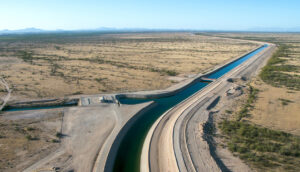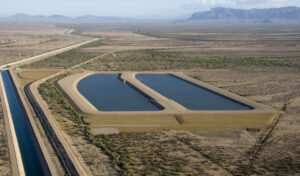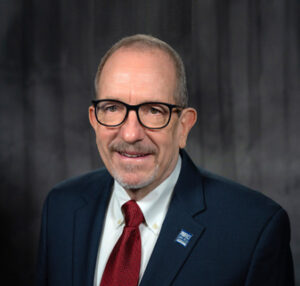The Central Arizona Project (CAP), as a junior holder of Colorado River water rights in Arizona, is feeling the brunt of the recent tier 1 supply cuts established under the 2019 Drought Contingency Plan (DCP) and triggered in 2021. In this interview with Municipal Water Leader Contributing Editor Jeff Kightlinger, CAP General Manager Ted Cooke tells us about the collaboration that was needed to establish the DCP and to set up the new 500+ Plan and discusses the programs that will be needed after they expire in 2026.
Jeff Kightlinger: Please tell us about your background and how you came to be in your current position.
Ted Cooke: I have more than 40 years of experience in operations, finance, project management, project development, and project financing. Before coming to CAP, I worked for around 12 years at a couple of independent power development companies. I came to CAP as the head of the finance department, the kind of role that had been a large part of my previous jobs, but that was not my original career aspiration. Being a finance person was kind of an accident. I was a physics major in college, I had an MBA in operations management, and I was hired by Xerox in Los Angeles to be an industrial engineer in an electronics manufacturing plant. But there was a mix-up, and when I reported to work, they said, “Well, we have this job for you as a financial analyst.” Thirty years later, a big part of my job is still finance, but I have also worked in operations and project development. After I had worked at CAP for 16 years, the general manager job became vacant, and I applied for it. I was hired as the interim general manager, and in 2016, after I had done that for a year, I was selected as the general manager.

Jeff Kightlinger: How has your finance background helped you be successful as a general manager?
Ted Cooke: From the perspective of working with the board and CAP customers, most of the business that is transacted is financially oriented: What projects are we working on, and how are they going to affect reserves and rates? That said, I don’t think that being a financial officer—or an attorney or even a water policy expert—will by itself make you a successful general manager. Fortunately, I had lots of exposure to policy people, lawyers, decisionmakers, and constituents in my earlier jobs. It was helpful to understand how those groups interact.
Jeff Kightlinger: Please tell us more about CAP and the Central Arizona Water Conservation District (CAWCD).
Ted Cooke: CAWCD was created in 1971 as a local agency that would contract for water with the United States and would repay the federal government for the reimbursable costs of building the CAP. It has expanded its mandate since then and now operates the CAP infrastructure and is a water delivery agency as well. Most of the time, it is simply known as CAP because it is identified with the infrastructure it operates. CAWCD delivers the portion of Arizona’s Colorado River water that is not used by senior water rights holders on the mainstem. Up until recently, that was a little more than half the 2.8 million acre-feet that Arizona is apportioned. CAP has a junior priority both in Arizona and in the lower basin, and in the current era of shortage, all the reductions to Arizona’s water supply have been taken from CAP’s supplies. Now, rather than getting a little more than half the state’s allocation, we get slightly less than half.
Jeff Kightlinger: Would you tell us what you’ve been doing to prepare for this shortage?

Ted Cooke: The shortage did not come as a surprise. We’ve been preparing for this for over two decades, first with the 2007 guidelines, which were basically a set of operating rules adopted by the secretary of the interior. They defined how the lower Colorado River would be operated in times of shortage and what sorts of reductions in supply would be taken by the three lower basin states (Arizona, California, and Nevada). Since then, we’ve had to make some amendments and modifications. The most recent was the DCP, implemented in 2019, which increased the amount of the reductions. For the lower basin, the elevation in Lake Mead is what determines when a shortage will occur and how much it will be. There are three reduction tiers under the 2007 guidelines, and the DCP added an additional tier.
We’re doing some collaborative voluntary conservation in the lower basin states, both with each other and with the Bureau of Reclamation. Leading up to the implementation of the DCP in 2019, we were actually implementing what was later to become the new tier zero, the basic layer of reductions that would be taken under the DCP. We did that for 4 years to keep the system from going into shortage before we were formally required to do so in 2020. However, moving from tier zero to tier 1, which is happening in 2022, is a big step, particularly for Arizona. It requires a reduction in use that is 2½ times greater than what we did to get to tier zero. But we are ready for that, too, because the decisions about what elevation would trigger tier 1, the size of the reduction in deliveries, and whose supplies would be reduced had already been made.
Jeff Kightlinger: You went through quite an elaborate process to get consensus on those plans. How were you able to bring that group of diverse stakeholders together?

Ted Cooke: For about a year and a half, we had strong disagreements in Arizona, particularly between CAP—the junior priority holder and the one organization upon which all the consequences of the DCP were going to fall—and the state. But after a year and a half of wrangling, the state and CAP came together and co-led the statewide discussions. The talks included representatives from all sectors, including legislators, cities, tribes, nongovernmental organizations, leadership organizations, irrigation districts, and developers. From the original 200 participants, we formed a steering committee of about 40 people, and that became an effective tool for reaching consensus. We realized early on that we would not be able to get the legislature to take the necessary action without a broad consensus. We held these meetings in public, and the process garnered substantial media attention. People from throughout the state were engaged. We ultimately got nearly unanimous approval for the DCP in both houses of the state legislature and then took it to Congress, where the same thing happened.
Then, we had to go home and implement the DCP, and that’s when the fireworks started. We knew that because of the priority system within Arizona and because central Arizona agriculture and the homebuilders and developers had the lowest-priority water rights, those groups were going to be the hardest hit. Those two sectors had lots of influence in the legislature and could effectively block the legislation, but we were ultimately successful in gaining their buy-in. The key to reaching consensus was mitigation for the significantly affected lower-priority users, which involved water that was voluntarily contributed by higher-priority users and funding that was contributed by the state, CAWCD, and others. Mitigation is a temporary program that eases the effects over the first few years of shortage.
Jeff Kightlinger: Please tell us about the 500+ Plan that CAWCD and the State of Arizona, along with parts of California and Nevada, recently entered into.
Ted Cooke: In addition to the specified reduction tiers, there is an adaptive provision of the DCP that requires additional actions if any monthly forecast indicates that Lake Mead may fall below a certain level over the next 2 years. We knew that condition would be met eventually, but it caught us by surprise when it was triggered in August 2021, which happened to be the same month when tier 1 was triggered for 2022. We quickly did some modeling to determine what additional actions would be needed, and we determined that it would take 500,000 acre-feet per year of additional conservation for the next 5 years. It took only 4 months to develop what became the 500+ Plan. So, while we were implementing a tier 1 shortage for the first time in 2022, we had to simultaneously implement the 500+ Plan. We’re still developing all the agreements to put the 500+ Plan in place for 2022 and 2023, the first 2 years of this 5‑year period. The understanding is that the actions we take this year and next are not going to be effective by themselves; we’re going to have to do more. Five hundred thousand acre-feet is the minimum savings that we need to meet every year from 2022 through 2026, in addition to the reductions required under tier 1 and whatever other tiers we hit.
Jeff Kightlinger: So you have the 2007 guidelines, the DCP, and now the 500+ Plan, all layered on top of each other and effectively all expiring in 2026. What do you think a new agreement needs to look like in 2026?
Ted Cooke: That is really the big question. We don’t just want to keep having to conserve more. That will not necessarily arrest the declines in Lake Mead, and, at some point, we will have reached the limits of what we are able to cut. The one thing that we can’t control is the hydrology— how much precipitation falls from the sky. At very low levels in the reservoirs, including Lake Mead and Lake Powell, we could eventually have a situation where the only water available is the run of the river, and there could be significant unplanned reductions, but nobody wants to get to that point. To prevent that, we need to continue engaging in adaptive management and having collaborative discussions about what to do next. Some people have the idea that we need to just start over and do something different. I think that is hubris. What do you do in the meantime, while you’re creating this new thing to replace what took more than 100 years to achieve in the first place? What’s going to happen in the interim? How do you prevent litigation and other consequences?
The time is short to get something else done by the end of 2026, particularly since we are going to have to go through an environmental review under the National Environmental Policy Act, which doesn’t happen quickly, and we are going to have to go to Congress. There is going to be a presidential election in 2024, so the timing is not helpful. Lots of folks have already started to speculate that the guidelines and the DCP may be extended for a couple of years to give us more time. That’s not an entirely bad idea, particularly as we are constantly working on what I refer to as adaptive management.
Jeff Kightlinger: What do you think is needed from Reclamation to help get a new agreement done by 2026 or shortly thereafter?
Ted Cooke: The Biden administration quickly put seasoned water professionals into key spots in the U.S. Department of the Interior, people that most of us know fairly well. I think the major challenge right now—something that the federal government can do best—is to facilitate the conversation between the upper basin and lower basin states, tribal users, and nongovernmental organizations. We need to develop a common understanding of the issues that are going to get in the way, whether we start over or continue adaptive management. We need to agree on things such as how much water the Colorado River has and the appropriate arrangement between the upper and lower basins. To agree on that for the next 10, 20, or 50 years, those fundamental differences of opinion need to be resolved.

Jeff Kightlinger: You’ve been at the helm of CAP for the last 7 years, a pretty tumultuous time in which we have really started to see the effects of climate change and shortage. What is your vision for the future?
Ted Cooke: The type of shortage that we’re having on the Colorado River right now may be the new normal. There was always the idea that if we were going to build the CAP infrastructure, we wanted to use it for other things as well, so from the very beginning, CAP was oversized. The consensus is that we need to use this excess capacity to put more water in the CAP aqueduct at some point. Well, that point is now. While we are working on conservation, we also need to think about finding new supplies. We call this augmentation. Can we find a way to use treated water that is currently going into the ocean? Can we build a desalination plant to treat ocean water and bring it here? Can we import water from other areas of the country that have a surplus? These things sound insurmountable and incredibly expensive, and they are, but so was the construction of the CAP or of the Metropolitan Water District of Southern California. We thought that we’d never have enough money or political willpower to do these things, but we did them, so we can’t dismiss any of those types of solutions. During the term of the next set of guidelines, we’re going to reach the end of our ability to conserve, and we have to have these other things in place. It takes time to build a plant, develop infrastructure, or work your way through all the environmental and contractual issues involved in building a desalination plant in Mexico or a pipeline from Missouri. We have to start working on that stuff now so that when our ability to conserve hits the limit, these other projects have become viable. That’s going to be our focus over the next 10 years. The longer we wait, the longer there’s going to be a gap between those two things.
Ted Cooke is the general manager of the Central Arizona Project. For more about CAP, visit cap-az.com.

